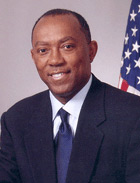Believe it or not, the County Clerk’s office put out draft canvass reports last night. As a result, I can do the thing that I do. Here’s a look at the Mayor’s runoff race:
Dist King Turner
=====================
A 9,491 5,472
B 1,356 17,406
C 19,866 16,004
D 3,368 20,245
E 20,108 5,600
F 4,664 4,005
G 28,193 6,892
H 4,070 7,317
I 3,605 5,894
J 3,412 3,012
K 5,791 12,718
A 63.43% 36.57%
B 7.23% 92.77%
C 55.38% 44.62%
D 14.26% 85.74%
E 78.22% 21.78%
F 53.80% 46.20%
G 80.36% 19.64%
H 35.74% 64.26%
I 37.95% 62.05%
J 53.11% 46.89%
K 31.29% 68.71%
The Chron used this data to create some maps – a City Council district map, a precinct map, and a turnout map.
Remember as always that this is Harris County data only. Turner did win Harris County, by a small amount. The bulk of his margin is in Fort Bend, which is mostly in District K. You have to give King some credit. He won F and J after having trailed in them in November, and he carried C by a fairly healthy amount. I thought if he won in C he’d be in a strong position to win overall, and he came close to that. In November I suggested that King needed to duplicate Jack Christie’s 2011 runoff performance against Jolanda Jones to win. A performance like Christie had in District C would have done it for King, but he had some other avenues as well. Two questions to ponder in analyzing this result: How many previous supporters of Garcia and Bell and Costello did King move to his column, and how many new voters did he bring out? I will try to get a handle on that when I get a copy of the voter roster. A question I’m not sure how to answer is why did King do better on Election Day than he did in early voting, despite the expectations of some pundits? Turner clearly did a good job getting his voters out early. Maybe that’s all there was to it.
As for Turner, he did what he had to do. His margins in districts B and D were awesome, but it wasn’t just about the percentage, it was about the absolute total. It’s clear Turner needed the high turnout he got in those districts, but I think it’s an oversimplification to credit his win to “high turnout”, as I’d argue that King benefited from it as well. I’d love to see someone dig up precinct information from the 2001 Mayoral runoff between Lee Brown and Orlando Sanchez and do a side by side comparison with this year. I’m guessing there would be a lot of overlap.
I’ll be looking at the other races over the coming days. This result is understandable by looking at the numbers, as both candidates did what they needed to do, with Turner ending up on top. Some of the others are more of a puzzle, especially given the context of the Mayoral race. But we’ll get to that when we get to that. What are your impressions?


All the fireman in my neighborhood had multiple Turner signs in their yard. I think they made the difference in the election. We will see what Turner can deliver for them. I suspect it is only a matter of time until they have a basic 493(b) like the country regardless of who the mayor is.
Jason, the county uses mostly volunteer firemen but in terms of cost, county employees have both social security and participate in the state pension plan so it’s not really a 403-b plan as King proposed and it certainly wouldn’t save as much money as some people think to convert.
My guess is that firemen who live inside the City are a fraction of the 4,000 Turner win. Now, they put in a lot of money, and they may have worked phone lines and other volunteer stuff. But I have been told by both fire and police that 90+% live outside the City limits.
J, I’d be willing to bet that a large majority of city employees live within the city limits during at least part of their careers, many leaving for the suburbs for the same reasons others do (chasing better ISD’s, more affordable housing in decent areas). I didn’t notice the unions spending all that much money on the campaign compared to the millions spend by the candidates as a total but other than the endorsements, I know a few that did work the phones here and there.